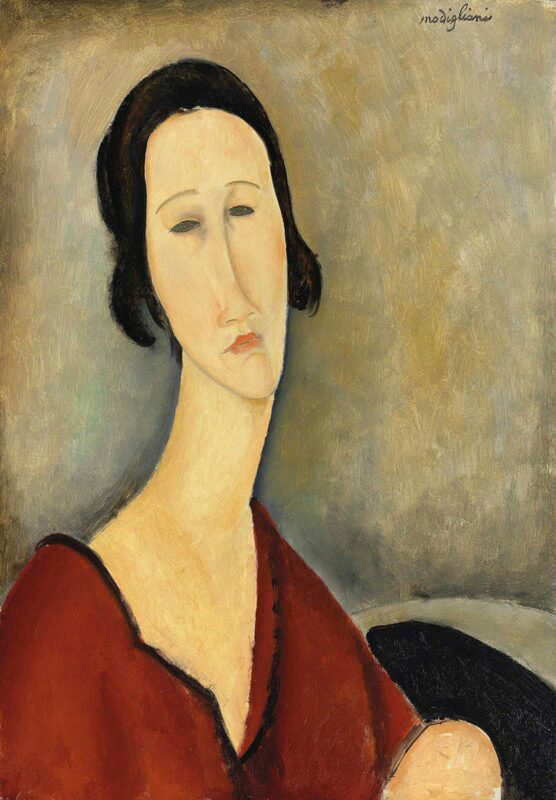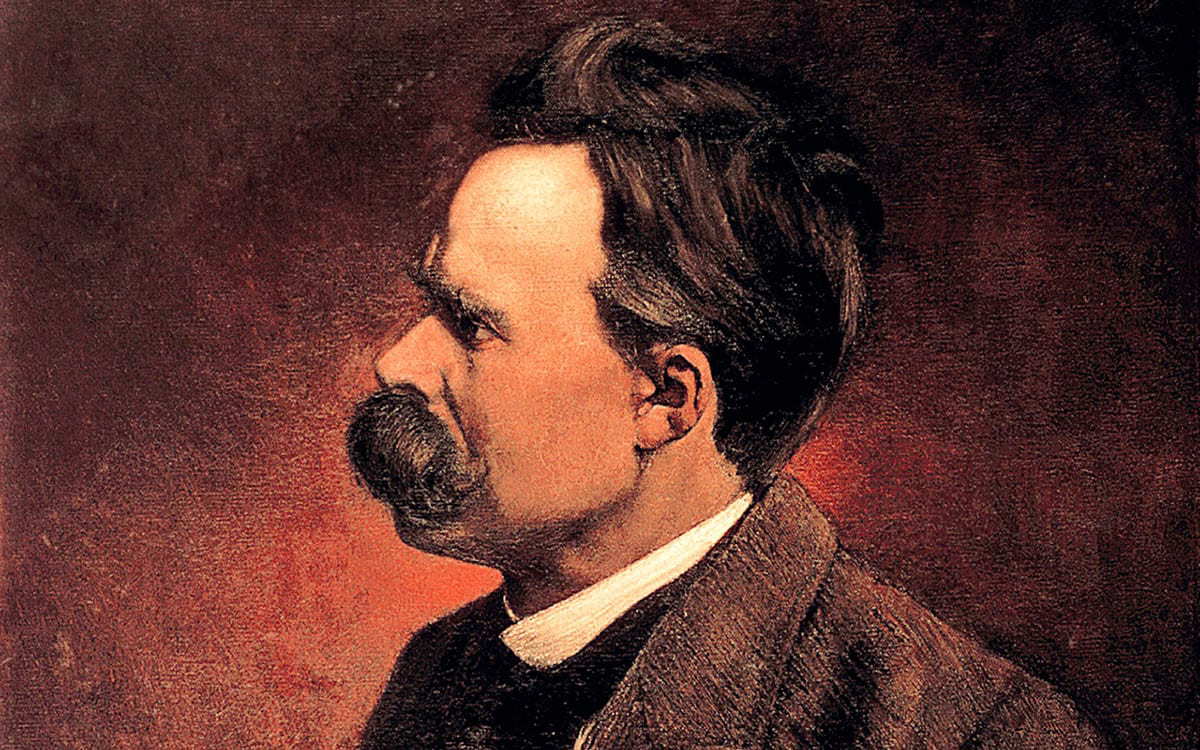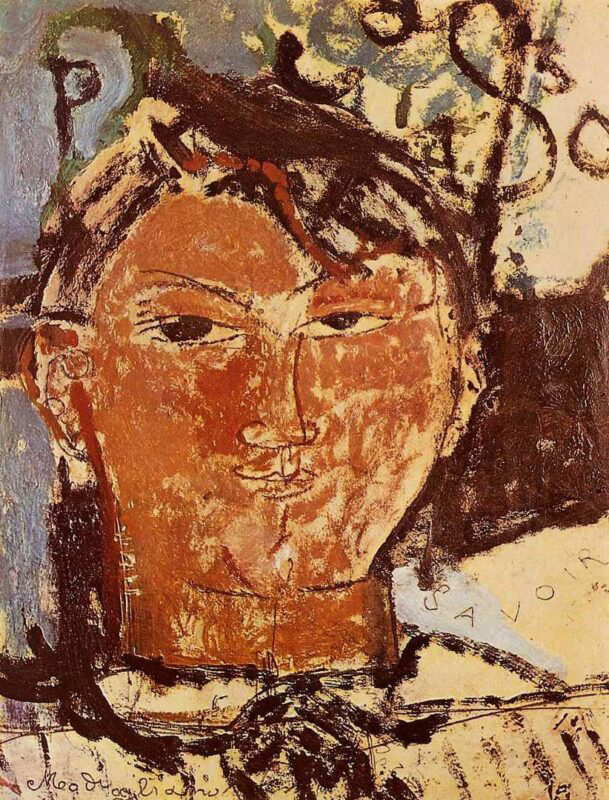
Italian painter Amedeo Modigliani’s work is easily among the most instantly recognizable in western art history, and his name stands alongside the likes of Pablo Picasso and Piet Mondrian as a leading figure of early twentieth-century European painting. Unfortunately, during his life, he sold little of his work and was known as much for his habits of excessive drinking and drug-taking as he was for his creative talents.
However, his influence on his contemporaries was clear to see, even prior to his tragic death at the age of just 35. And it continued to be felt long afterward, as artists took inspiration from the Italian painter’s life and work.
Amedeo Modigliani’s Style

Amedeo Modigliani’s style is instantly recognizable. What’s more, it was unlike almost anything else that his contemporaries were doing at the time. While the Cubists and Post-Impressionists focused on the use of bright color and abstraction, Modigliani chose instead to delve into the human condition through one of art history’s most tried-and-tested methods – the portrait.
Modigliani said that he was not seeking the real or the unreal “but rather the unconscious, the mystery of the instinctive in the human race.” He often suggested that the eyes were the way into which we could uncover these deeper meanings, and this is why he focused so intently on people and portraiture.
Get the latest articles delivered to your inbox
Sign up to our Free Weekly NewsletterThe Italian painter’s work is often most easily recognizable in the shape of the people within it. Their long necks, bowed noses and forlorn eyes were specific to Modigliani’s style, and are no doubt one of the reasons now why his work is so popular.
What’s more, the color palette also stands out in most of his works as being ‘typically Modigliani.’ There is a great depth to the colors he uses, and their rich, warm tones are instrumental in creating his idiosyncratic style.
Importantly, though, painting was by no means his only artistic output. In fact, for much of his career, Modigliani is thought to have been much more interested in sculpting. The characteristic forms which appear in his paintings do, however, still find a home in his three-dimensional work.
If anything, his sculptures allowed him to even more powerfully construct his vision of people and the world around him. Though his paintings are by no means two-dimensional in their appearance, the physical weight which is inherent to the creation of a stone sculpture, give his three-dimensional work a particular gravitas.
Artistic Influences

Although the outcome may ultimately have formed very differently, Amedeo Modigliani was influenced in very much the same way as his Cubist friend Pablo Picasso. It is a well-established and long-debated trope that Picasso’s Demoiselles D’Avignon (among others) was influenced by African masks – which had become a popular collector’s item in France at the time given the country’s colonial connections and history.
He was also, like many artists living in Paris in the early part of the twentieth century, heavily influenced by philosophical and political literature. Just like his ancestors, who had been Talmudic scholars, he too was quite the bookworm and philosophy fanatic. His own experiences of struggle no doubt played a significant role in his particular interest in Nietzsche.
Like many others of his era, he was also heavily influenced by the poetry of Charles Baudelaire and Comte de Lautréamont. Particularly, Baudelaire’s focus on decadence and vice proved to be influential in Modigliani’s outlook as he followed in his footsteps when it came to indulging in such extravagances.

Artistically, however, the influences of the Parisian art which had drawn him to the city are also clear. Although the Italian painter was stylistically often alienated from his contemporaries, there are clear expressions of influence from the likes of Henri de Toulouse-Lautrec, who had dominated the generation of artists previous to his own. Particularly, it’s possible to relate Modigliani’s portraits with those Toulouse-Lautrec made of dancers in their dressing rooms at his favorite haunt, the Moulin Rouge.
Friends Of The Italian Painter

As mentioned, Amedeo Modigliani was well acquainted with many of the other leading lights of his artistic generation. For a period, he worked out of Picasso’s Bateau Lavoir in Montmartre. Before his untimely death, he had been able to establish a strong reputation among his artistic friendship circle – if not beyond that in the realms of the minds of the critics or public.
He was close friends with the Welsh painter Nina Hamnet, who had moved to Paris in 1914, and famously introduced himself to her as, “Modigliani, painter and Jew.” He also knew and worked closely with the Polish sculptor Constantin Brâncuși, with whom he studied sculpture for a year; as well as Jacob Epstein, whose bulky and powerful sculptures had a clear influence on Modigliani’s work.
He was also acquainted with Giorgio de Chirico, Pierre-Auguste Renoir and André Derain, all of whom he was particularly close to when he moved to the South of France during the First World War.
Illness and Death

Amedeo Modigliani had always been a sickly individual. As a child he had suffered from Pleurisy, Typhoid Fever and Tuberculosis, all of which caused him great distress and resulted in his being homeschooled by his mother for much of his childhood.
Although he largely recovered from his childhood bouts of illness, the Italian painter’s adult life would not be freed from them entirely. He was often perceived to be socially challenged, which may have been a result of his isolated upbringing.
Even more tragically, his wife, Jeanne Hebuterne was so overwhelmed with grief that just two days after his death, she threw herself from the fifth story window of her parent’s home where she had gone to stay. At the time, she had been six months pregnant and so killed herself and the pair’s unborn child.
The two were buried separately at first given her family’s long-standing dislike for Modigliani who they deemed a ne’er-do-well and an XXX. However, in 1930 the family finally made provision for her body to be moved to the Père Lachaise Cemetery in Paris to be laid to rest alongside Amedeo.
Their tombstones reflect the horrific nature of each of their demises, with Modigliani’s saying, “struck down by death at the moment of glory” and Hebuterne’s poignantly describing her as his “devoted companion to the extreme sacrifice.”
Influences On Others

Despite his untimely death, and the relative anonymity he saw professionally during his life, Amedeo Modigliani’s work continued to provide inspiration to artists the world over – even beyond his immediate circle. His sculptures were an influence on the British modernist artists, Henry Moore and Barbara Hepworth.
His trip to the South of France in 1918 appeared also to leave an impact on the work of those artists he spent time with. In particular, André Derain’s copper-embossed Portrait (1918-19), which he made in the same year, bears a striking resemblance to Modigliani’s style.
Meanwhile, his paintings have influenced countless artists throughout the century or so since his passing. One notable example is the work of Margaret Keane, whose famous big-eyed portraits of children not only swept the world by storm in the 1960s but also inspired the 2014 biopic, Big Eyes, starring Amy Adams and Christoph Waltz.
Significantly, his friendship with Diego Rivera meant that his work became a particular source of inspiration for Frida Kahlo, whose paintings bear an obvious nod to Modigliani’s own. Particularly her self-portraits, of which there are many, share the long-necks and detached facial expressions that were a staple part of Modigliani’s oeuvre.
Amedeo Modigliani In Pop Culture

Amedeo Modigliani’s influence continues to be felt in the art world and beyond to this day. His artworks continue to fetch higher and higher prices at auction houses around the world, which is somewhat ironic given the relative poverty which he experienced during his life – and in 2010, his Tete (1912) became the third most expensive sculpture in the world with an eye-watering price of €43.2 million.
What’s more, while many artists continue to be influenced stylistically by the Italian painter, there are numerous references made to his work throughout popular culture. Most strikingly, the famous horror director Andy Muschietti has included references to Modigliani’s work in a number of his films.
In Mama (2013), the terrifying title character resembles a Modigliani-esque figure with disconcertingly stretched features. In IT (2017), a Modigliani-esque painting comes to life and the figure within it haunts the young son of a Rabbi as he prepares for his bar mitzvah.
His obsession with Modigliani’s style and his association of it with the feeling of fear came from his assertion that as a child he didn’t see the artistic merit or style contained within the Modigliani painting which his mother had on the wall. Instead, he could only see a deformed “monster.”
Beyond this example, and despite the relatively short time which he spent working as an artist, Amedeo Modigliani’s story is clearly one which continues to capture the imagination of art lovers around the world. Since his death, there have been countless books (both fictional and non-fictional) about his life; there have been plays written; and even three feature-length films detailing his life story.








